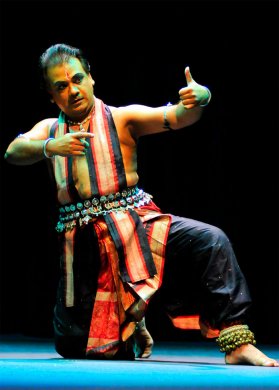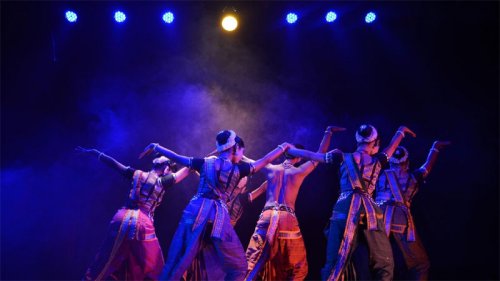
|
 |

|
 |
Ratikant Mohapatra: Good art will always triumph - Lalitha Venkat e-mail: lalvenkat@yahoo.com Photos courtesy: Srjan September 3, 2017  September 3 is the founding day of Srjan. As Srjan gears up to conduct the 23rd edition of the Guru Kelucharan Mohapatra Award Festival from September 5 to 9, 2017 at Rabindra Mandap, Bhubaneswar, its director Guru Ratikant Mohapatra shares his thoughts as an organizer and choreographer. In a place that has dance programs and festivals through the year, what do you think makes GKMA Festival special / stand out from the rest? The popularity of our festival can be gauged by the near riot conditions outside the hall among those who do not have invitation cards. Over the years the audience has had a taste of the meticulous preparations made for every minute of this five day festival. The audience keeps coming back, in overflowing numbers, because they have experienced the "perfectionist" attitude of our organization. It has been Srjan's policy to present the biggest names in Indian classical dance and music (as well as some rising stars and evolving artistes who make their presence strongly felt by their performances) to an Odia audience most of whom would never have seen them perform. To experience at close quarters the stellar presence of top-notch classical performers is an irresistible attraction. We strive to create a serious and tasteful ambiance in all aspects of the festival - from the hoardings, ads, invitation cards and souvenir to the smallest comforts needed by a variety of artistes and esteemed guests from all corners of India; we work very hard to ensure that they are totally satisfied with the arrangements. A number of other festivals through the year have tried to emulate many aspects of our event; a few succeed in copying the external parameters but Srjan's inner resolve to present, year after year, a flawless and aesthetically superior ambiance is hard to copy. In the 23 years of the festival, in what way has the financial/sponsorship support changed over the years? It is true that things are getting difficult on this sponsorship front. Dark clouds are looming on the horizon and the foreseeable future looks troublesome. So far the saving grace for Srjan has been that regular donors usually oblige in supporting a top-notch festival and by all standards a deserving Gharana. But since the number of festivals is increasing by the year, the same corpus tends to get divided among a growing number of aspirants. The eminence of Guruji and his worldwide fame has made it easier to garner Government and Corporate support. But much depends on our ability to sustain the good work, quality and polish of the last two decades. However, we incur a heavy expenditure in organizing this five day festival and we are on the constant lookout for new and well-meaning donors who will appreciate the meticulous care taken in upholding the tradition of a cultural heritage. I would like to record here that the Odisha Government has been very understanding and supportive of our efforts to sustain the fragile tradition of Odissi dance and music. The Government of Odisha needs to be appreciated for helping and encouraging not only us but a number of other sincere efforts in the field of traditional arts.  With so many Odissi dance events happening, do you think it is a good sign orů.? From the dawn of creation there has been the good, the bad and the indifferent. So also in dance. With the number of performances proliferating, the good sign is that young dancers get a platform in the competitive world of Odissi presentation. Out of these a few gems emerging would be a welcome thing. The dark side is that some organizers of minor festivals exploit the dancer. The poor dancer has to pay for everything and hardly gets either a good audience or good publicity. Waste of talent, effort, money and time. The scene, however, is slowly changing for the better as discerning audiences have begun to cold shoulder run-of-the-mill events which even the normally hungry media neglect. The increasing number of Odissi shows means that Odissi gets more well known, better understood and more desired. While this in itself is a good sign, it becomes our responsibility as artistes not to cross the Laxmana rekha of discipline, honesty, aesthetics and performance values. How do you choose your Yuva Prativa Samman awardees? There will always be a number of talented and competent dancers in any style. At Srjan, our effort is to choose the special ones among them who not only perform well but are emotionally connected with the dance and its tradition or the music and its timelessness. The peak period of a dancer's life is usually between the ages of 25 and 40. In choosing the Guru Kelucharan Mohapatra Yuva Prativa Samman awardees, we look for dancers and musicians who are very presentable not only today but give promise of unending improvement in their craft and the rare dedication to sustain their art throughout life. Only such people evolve into complete performing artistes. They would grow from strength to strength. You call your style of choreography neo-Odissi. What are the subtle variations of this from the pure classical style of Kelubabu? In the1960s when my father and guru Kelucharan Mohapatra embarked on new compositions (for example Hamsadhwani pallavi and Kirwani pallavi), people thought of them as innovations and accepted them whole heartedly. In effect this was neo-classical Odissi. He stayed within the confines of the Odissi tradition. I too do not make any radical departure from these confines. In my choreography of dance drama, traditional and experimental items, I have tried to give a new look to compositions which are solidly rooted in the tradition of Guruji's style and work. For example there are features in the movement and music of 'Allah,' 'Mrytyu,' 'Om,' 'Samakala,' 'Tarana,' 'Bishwas' and 'Synthesis' which are not usually seen in Odissi presentations but bear the stamp and character of Guruji's style. Any innovations I have introduced like sideways leaning and stretching on a static position, presenting high speed sequences and unusual ornamentation in body movements, footwork and rhythm passages - all these are designed to give the dance a new and interesting look. These are only some of the many aspects of choreography which are being described as neo classical Odissi. To attain unusual speeds of movement and footwork the dancers have to be in peak fitness and practicing throughout the year. This is a very painstaking effort for the dancer as well as the choreographer. "Neo classical Odissi" is a level not easy to live up to! There is no difference between Guruji's idea of classicism and my understanding of it. After all, I have spent 35 years of my life closely following his work and participating in his dreams. Guruji always looked for new ways to present the traditional. Broadly speaking my search is the same as his.  With dwindling support for the arts everywhere, what do you foresee for the future? The phenomenon of "dwindling support for the arts everywhere" is, I believe, a distressing but temporary one. There are also signs of renewed interest in the liberal arts all over the world. In my own limited experience I find many parents and their teenage children showing welcome enthusiasm for music and dance. Since society does not tolerate a vacuum, I hope that a burgeoning interest in performing arts will draw onto itself adequate support and even patronage. The present, though, is taxing. The sanctity and longevity of the art will always be undiminished. Without adequate support the journey of the art form in our lives will certainly be challenging. But good art will always triumph and remain strong. Contact Ratikant Mohapatra: srjan.bbsr@gmail.com Post your comments Unless you wish to remain anonymous, please provide your name and email id when you use the Anonymous profile in the blog to post a comment. All appropriate comments posted with name & email id in the blog will also be featured in the site. |